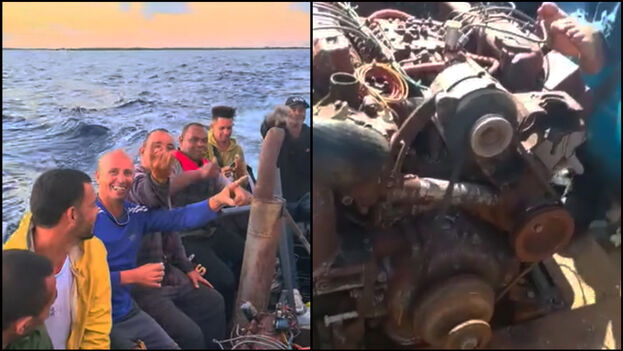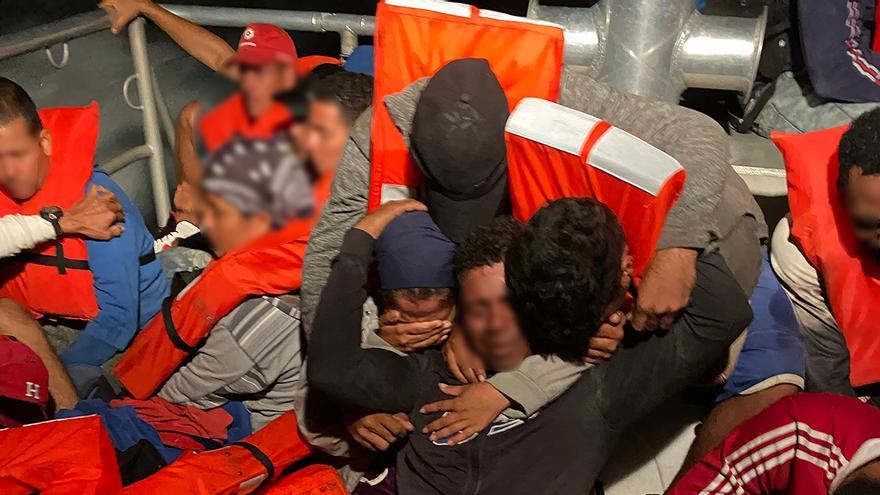
![]() 14ymedio, Havana, 6 DecemberThe Cuban Leitian Cedré shared on Facebook last Saturday two videos of the journey of at least 20 rafters who managed to disembark in the Florida Straits after 19 hours on the water. “I know that the brothers who could not come in this round will make it and they will be able to get out of suffering at any moment,” he confided.
14ymedio, Havana, 6 DecemberThe Cuban Leitian Cedré shared on Facebook last Saturday two videos of the journey of at least 20 rafters who managed to disembark in the Florida Straits after 19 hours on the water. “I know that the brothers who could not come in this round will make it and they will be able to get out of suffering at any moment,” he confided.
The rafters, originally from the province of Matanzas, set sail in “one of the best rustics that has come out of Cárdenas,” Cedré proclaimed. A diesel engine from a Russian Kamaz V8 type truck was adapted to the raft. This type of vehicle is used on the island to transport sugarcane or merchandise.
Cedré recommended to those who are about to leave Cuba, to put “the spirit and fight into it a little more so that they see that everything is achieved.” No further details were provided about the rest of the group, while the rafter shared a second video in which they are fueling a boat, in which, he said, they will go fishing.
This Tuesday, the US Border Patrol took into custody 33 Cubans, seven women and 26 men, who managed to make landfall in the Florida Keys. The chief officer of the Miami sector, Walter Slosar, shared the images of two rafts in which the migrants arrived.
Slosar has documented in his networks the arrival of 88 Cubans so far in the last month of the year. Last Monday he reported two rustic boats in which 30 compatriots left the island. On Thursday, he commented on a raft with 25 people, including a child, from Matanzas who disembarked in Marathon.
As usual in these cases, the rafters have the option of requesting asylum, which implies demonstrating before an official or judge that their fear of returning to their country is justified. If the Cubans convince the relevant authorities, they are given a bond and can request asylum.

Several attempts to achieve the American dream have been thwarted by the United States Coast Guard. This Monday, 126 Cubans were repatriated aboard the ship Pablo Valent. Lieutenant Paul Puddington warned of the patrols being carried out in the Florida Straits, the Windward Passage and the Mona Channel “to prevent the tragic loss of life from these dangerous and illegal sea voyages.”
According to official figures, maritime surveillance has made it possible to thwart the arrival of 2,755 Cubans in Florida in the last three months. The US agency detailed that last year 6,182 rafters were detained.
The intercepted Cubans are returned to Cuba as part of a migration agreement between Washington and Havana, although on some occasions this does not happen, due to situations of credible fear of returning to the Island for repressive reasons. This is the case of 22 people, among whom is the activist Yeilis Torres Cruz, who are at the Guantanamo Base waiting for refuge in a third country.
The migratory crisis that the Island is experiencing is taking place above all by land. According to data from the US Department of Customs and Border Protection, 224,000 Cuban migrants arrived in the last year.
The crossing of the Rio Grand in the Mexican state of Coahuila, to reach the United States, continues to be a common route for island nationals. On Monday, the chief officer of the Border Patrol for the Valle sector, Texas, Gloria Chávez, reported the detention of “three groups of migrants” in the first four days of December, “a total of 420 migrants: 103 family members, 56 unaccompanied children, and 261 single adults from Cuba and several countries in Central and South America.”
#IslaEnFuga Llegan 20 cubanos a Florida en una balsa con el motor de un camión ruso Kamaz https://t.co/O38S84qNgZ | Video: Leitian Cedré/Facebook pic.twitter.com/ywFlSES27n
— 14ymedio (@14ymedio) December 6, 2022
____________
COLLABORATE WITH OUR WORK: The 14ymedio team is committed to practicing serious journalism that reflects Cuba’s reality in all its depth. Thank you for joining us on this long journey. We invite you to continue supporting us by becoming a member of 14ymedio now. Together we can continue transforming journalism in Cuba.
